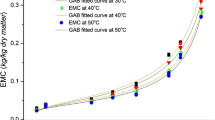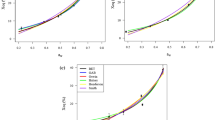Abstract
The sorption isotherms analysis and glass transition temperature should provide important information about the role of water in food. Sorption/desorption isotherms of freeze-dried jambolan (FDJ) were determined at 15, 25 and 35 °C temperatures. The determination of glass transition temperature is also performed in order to establish packaging and storage conditions. The hygroscopic behavior of jambolan pulp after freeze-dried process was studied through sorption isotherms and models fit to experimental data. The freeze-dried material was highly hygroscopic and Peleg’s model showed the highest coefficient of determination and lower values of average deviation and relative average error estimated, therefore the best fit sorption isotherms. The lowest value of monolayer was 7.64 gH2O·100g −1db to 25 °C. At temperature higher than 17 °C (T g), the material become more amorphous and the site of interaction with water molecules becomes available. As conclusion, the material must be storage at temperatures below T g and low relative humidity.



Similar content being viewed by others
References
Faria AF, Marques MC, Mercadante AZ. Identification of bioactive compounds from jambolão (Syzygium cumini) and antioxidant capacity evaluation in different pH conditions. Food Chem. 2011;126:1571–8.
Banerjee A, Dasgupta N, De B. In vitro study of antioxidant activity of Syzygium cumini fruit. Food Chem. 2005;90:727–33.
Valente A, Albuquerque TG, Sanches-Silva A, Costa HS. Ascorbic acid content in exotic fruits: A contribution to produce quality data for food composition databases. Food Res Int. 2011;44:2237–42.
Fernandes FAN, Rodrigues S, Law CL, Mujumdar AS. Drying of exotic tropical fruits: a comprehensive review. Food Bioprocss Technol. 2011;4:163–85.
Scott WJ. Water relations of food spoilage microorganisms. Adv Food Res. 1957;7(9):83–127.
Ceballos AM, Giraldo GI, Orrego CE. Effect of freezing rate on quality parameters of freeze dried soursop fruit pulp. J Food Eng. 2012;111:360–5.
Fabra MJ, Talens P, Moraga G, Martinez-Navarrete N. Sorption isotherm and state diagram of grapefruit as a tool to improve product processing and stability. J Food Eng. 2009;93:52–8.
Mrad ND, Bonazzi C, Boudhrioua N, Kechaou N. Influence of sugar composition on water sorption isotherms and on glass transition in apricots. J Food Eng. 2012;111:403–11.
Pavan MA, Schmidt SJ, Feng H. Water sorption behavior and thermal analysis of freeze-dried, refractance Window-dried and hot-air dried açaí (Euterpe oleracea Martius) juice. LWT Food Sci Technol. 2012;48:75–81.
Silva AE, Silva LHM, Pena RS. Comportamento higroscópico do açaí e cupuaçu em pó. Ciênc Tecnol Aliment. 2008;28(4):895–901.
Corrêa PC, Afonso-Júnior PC, Stringheta PC. Estudo do fenômeno de adsorção de água e seleção de modelos matemáticos para representar a higroscopicidade do café solúvel. Rev Bras Prod Agroind. 2000;2(1):19–25.
Hossain MD, Bala BK, Hossain MA, Mondol MRA. Sorption isotherms and heat of sorption of pineapple. J Food Eng. 2001;48:103–7.
Perdomo J, Cova A, Sandoval AJ, García L, Laredo E, Müller AJ. Glass transition temperatures and water sorption isotherms of cassava starch. Carbohydr Polym. 2009;76:305–13.
Diaz P, Lopez D, Matiacevich S, Osorio F, Enrione J. State diagram of salmon (Salmo salar) gelatin films. J Sci Food Agric. 2011;91:2558–65.
Roos YH. Glass transition temperature and its relevance in food processing. Ann Rev Food Sci Technol. 2010;1:469–96.
Bezerra TS, Costa JMC, Afonso MRA, Maia GA, Rocha EMFF. Comportamento higroscópico de pós de mangas das variedades coité e espada e avaliação das características físico-químicas. Ciênc Rural. 2010;40(10):2186–92.
Ferreira CD, Pena RS. Comportamento higroscópico da farinha de pupunha (Bactris gasipaes). Ciênc Tecnol Aliment. 2003;23(2):251–5.
Vieira AH, Figueirêdo RMF, Queiroz AJM. Isotermas de sorção de umidade da pitanga em pó. Rev de biol e ciênc da terra. 2007;7(1):11–20.
Gomes PMA, Figueirêdo RMF, Queiroz AJM. Caracterização e isotermas de adsorção de umidade da polpa de acerola em pó. Rev Bras Prod Agroind. 2002;4(2):157–65.
Lomauro CJ, Bakshi AS, Labuza TP. Moisture transfer properties of dry and semi moist foods. J Food Sci. 1985;50:397–400.
Sing KSW, Everett DH, Haul R, Moscou L, Pierotti RA, Rouquerol J, Siemieniewska T. Reporting physisortion data for gas/solid systems. Pure Appl Chem. 1985;57(4):603–19.
Yan Z, Sousa-Gallagher MJ, Oliveira FAR. Sorption isotherms and moisture sorption hysteresis of intermediate moisture content banana. J Food Eng. 2008;86:342–8.
Corrêa PC, Goneli ALD, Resende O, Ribeiro DM. Obtenção e modelagem das isotermas de dessorção e do calor isostérico de dessorção para grãos de trigo. Rev Bras Prod Agroind. 2005;7(1):39–48.
Jaya S, Das H. Glass transition and sticky point temperatures and stability/mobility diagram of fruit powders. Food Bioprocss Technol. 2009;2:89–95.
Author information
Authors and Affiliations
Corresponding author
Rights and permissions
About this article
Cite this article
de Santana, R.F., de Oliveira Neto, E.R., Santos, A.V. et al. Water sorption isotherm and glass transition temperature of freeze-dried Syzygium cumini fruit (jambolan). J Therm Anal Calorim 120, 519–524 (2015). https://doi.org/10.1007/s10973-014-4014-x
Received:
Accepted:
Published:
Issue Date:
DOI: https://doi.org/10.1007/s10973-014-4014-x




